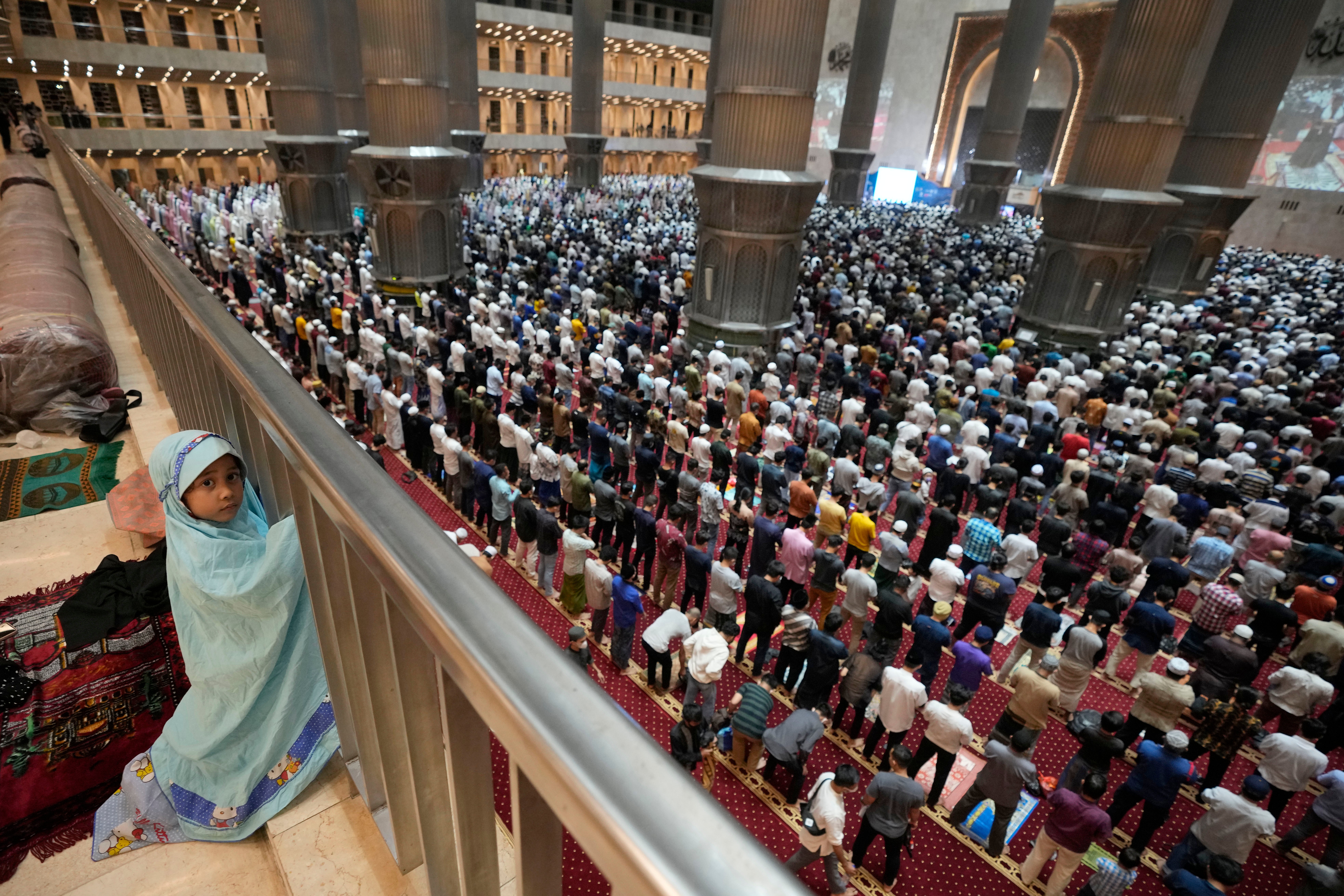Mosques have become ‘boys’ clubs’, despite what Islam really says
There’s reason to believe that while praying during the time of the Prophet Mohammed, women were not subject to radical barriers or sectioned off into insultingly small storage closets as we are today. This Ramadan, we need to be honest about the problem as well as the solution


Your support helps us to tell the story
From reproductive rights to climate change to Big Tech, The Independent is on the ground when the story is developing. Whether it's investigating the financials of Elon Musk's pro-Trump PAC or producing our latest documentary, 'The A Word', which shines a light on the American women fighting for reproductive rights, we know how important it is to parse out the facts from the messaging.
At such a critical moment in US history, we need reporters on the ground. Your donation allows us to keep sending journalists to speak to both sides of the story.
The Independent is trusted by Americans across the entire political spectrum. And unlike many other quality news outlets, we choose not to lock Americans out of our reporting and analysis with paywalls. We believe quality journalism should be available to everyone, paid for by those who can afford it.
Your support makes all the difference.A clandestine back door. A closet more suitable for storage space than multiple bodies in motion. Cramped spaces, often an architectural afterthought. These are details that many Muslim women will recount from their visits to mosques — houses of worship that today, are built mainly with men in mind.
In fact, many mosques across the globe — from the US and UK to countries in the Middle East — were completely closed to women during the pandemic. Mosque officials often cited social distancing and capacity restrictions as the reason for banning females from the buildings, while giving their allocated prayer spaces to men instead.
This Ramadan, many mosques have finally reopened their female prayer spaces to women. But while some have expressed joy at the prospect of being able to return for the Holy Month’s traditional taraweeh prayers which are held each night, there are women for whom being permitted entry into to mosques once again is no major feat at all.
While I consider myself spiritual and on a constant quest to better connect with my faith, I must admit that I don’t really enjoy visiting mainstream mosques. My reluctance stems partly from laziness and partly from a distaste of being enclosed in small spaces with noisy children, who are seen as their mothers’ and not their fathers’ responsibilities — but mostly from something else entirely. On principle, I don’t believe a house of worship should be divided so drastically between genders, with men earning privileged access to the main, grand halls, often complete with decorative carpets and chandeliers, while women are relegated to much smaller, closet-like spaces in the back, basement, or upstairs, often with no view at all of the imam leading the prayers.
While there are new, egalitarian, progressive and inclusive mosques in the States and Europe, some which host men and women in the same prayer space, and a few which even allow women to lead prayers (as African-American Muslim scholar Amina Wadud famously did in New York City in 2005), these are rarities, and are often deemed unorthodox by more conservative Muslims.
Mosques are meant to be inclusive for all worshippers. But because men continue to act as gatekeepers of the faith, drawing on centuries of cultural patriarchy, these spaces can often come across as hostile to women. This is why Scandinavia’s first female imam, Sherin Khankan, founded the women-led Mariam Mosque in Copenhagen. It also motivated American author and activist Asra Nomani to pen an entire book centered on her experiences feeling like a “second-class citizen” at her local mosque in West Virginia. In Standing Alone: An American Woman’s Struggle for the Soul of Islam, she cites a survey that found that the practice of women praying behind a curtain or in another room was becoming increasingly popular in the US.
By contrast, during the Prophet Mohammed’s time in Medina, the community mosque was much more welcoming to women, without barriers between genders. His wives were housed on the mosque’s grounds, and women participated publicly in religious activities. While women ordinarily pray behind men in mosques today, some scholars believe that women and men prayed in groups side-by-side at the Prophet’s early mosque — a tradition that was discontinued by later jurists in favor of placing women so far behind men that they were eventually relegated to zones further demarcated with barriers, curtains and separate rooms. An exception to the norm is the one and only Kaaba in Saudi Arabia: deemed the holiest site of Islam, it is a circular space where there are no physical barriers separating women from men.
Patriarchy has nonetheless perversely prevailed in “mosque culture” around the world, where gender-driven power structures often prevent women from being able to worship without feeling inferior to the men who dominate the space. In defending their male-centered approaches to mosques, some authoritarian religious leaders fall back on a quote where the Prophet reportedly said, “The best place for a woman to pray is in the innermost part of her home”. Yet this statement is often taken out of context, disregarding the particular conversation it was spoken in (women felt left out of earning blessings through mosque prayers as they had children at home to care for), and ignoring the fact that it was intended as a “concession” to women, not a “commandment.” In fact, UCLA Islamic Law professor Khaled Abou El Fadl points out, in his book, Speaking in God’s Name: Islamic Law, Authority and Women, that due to social resistance to reforms regarding women’s rights, the Prophet felt impelled to specifically command men to not prevent women from attending prayers to mosques.
While Muslims view the Prophet’s example as one to religiously follow, his attitude towards women in mosques has unfortunately been eclipsed by misogynistic customs that offer little incentive for women to visit the religious buildings that should be warm and welcoming community spaces for them — particularly during the month of Ramadan, which places an emphasis on gathering as a community.
Some of us have found alternative community spaces, which do platform women’s voices. Last night, my virtual Islam and Gender book club, headed by Leeds-based Dr. Sofia Rehman, met over Zoom to discuss this week’s chapter of The Veil and the Male Elite (1991) by Moroccan Muslim feminist, Fatima Mernissi. “Male supremacy can only exist and be consolidated if the public/private division is maintained as an almost sacred matter,” she wrote, making sure to clarify that there’s nothing sacred at all about the way that “modern Islam” has severely segregated the sexes at mosques. When Dr Rehman asked us all what we would like to see at mosques, the chat box was bursting with enthusiastic suggestions. The appetite is clearly there for better-built mosques that treat women’s experiences with as much priority as men’s.
Many Muslim women have written about and campaigned for better access, facilities and rights at mosques. I’m certainly not the first, and definitely won’t be the last, to bring attention to this issue. But I do believe we currently find ourselves at a unique crossroads. Having had little to no access to mosques at all for two years, now that we’re being “allowed” back in, let’s use the opportunity to make ourselves heard, rather than appearing content with our old storage closets, dingy basements and viewless balconies. What would we like our spaces to look like, and how can they better accommodate our needs as women, and as equal members of the faith and community? Who is willing to hear our demands — and better yet, implement them, following the spirit of our faith’s exemplary leader?
While I am attracted to the idea of separate, female-only mosques that embody the accessible and approachable vibes Muslim women like myself so desperately seek, I can’t help but view them as problematic for the overall quest for mosque inclusivity. Does the intolerance towards women run so deep that we cannot hope for change within the existing system, and must instead create our own community spaces, to the exclusion of men? In our plight to fight the radical segregation, might we just end up further segregating ourselves?
Muslims across the globe seek “fresh starts” during Ramadan, and these are questions to reflect on as we think about how best to reclaim our rightful spaces in the mosque — for our generation of women, and those who will follow us.
Join our commenting forum
Join thought-provoking conversations, follow other Independent readers and see their replies
Comments